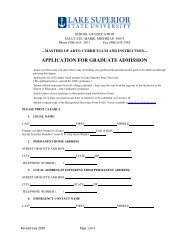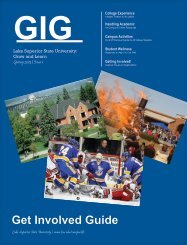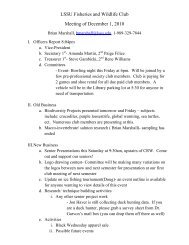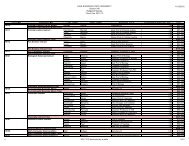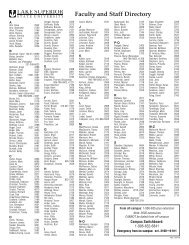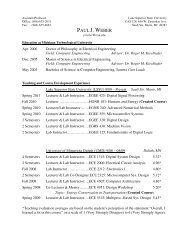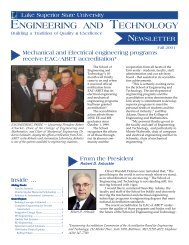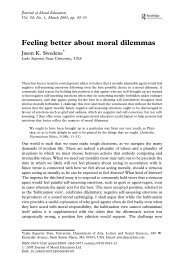Laarman and Ryckman - Lake Superior State University
Laarman and Ryckman - Lake Superior State University
Laarman and Ryckman - Lake Superior State University
Create successful ePaper yourself
Turn your PDF publications into a flip-book with our unique Google optimized e-Paper software.
34 LAARMAN AND RYCKMAN<br />
Table 1. Number of marked <strong>and</strong> recaptured fish<br />
caught with trap nets in Manistee <strong>Lake</strong>,<br />
1974-1978.<br />
Species<br />
Length Number<br />
range •<br />
(cm) Marked Recaptured<br />
Bluegill 10.2-22.7 13,670 486<br />
Pumpkinseed 10.2-22.7 20,105 1,125<br />
Rock bass 10.2-25.2 1,830 190<br />
Black crappie 12.7-32.8 5,827 693<br />
Yellow perch 12.7-32.8 3,775 104<br />
Walleye 25.4-58.2 3,063 366<br />
Smallmouth bass 15.2-32.8 3,093 322<br />
White sucker 38.1-58.2 1,772 77<br />
a Fish outside of the length ranges were captured occasion-<br />
ally, but in low numbers.<br />
2O<br />
R/M -266530 + 35.330 L- 1.4531' + 0.0193E<br />
(R'=O.18)<br />
•15 / • /<br />
• / \<br />
• / •• //<br />
a. /•<br />
•5 / /•<br />
/<br />
/<br />
i I I I i<br />
15 20 25 50 55<br />
Length (cm)<br />
Fibre 1, RelaQo•hip bet•ee• the pe•ce•Se<br />
the population <strong>and</strong> the number of recaptured (R)<br />
fish were determined. The end result was five R/ (•2 st•d•d errors).<br />
M ratios (one per year) for each 2.5-cm length<br />
group per species. No attempt was made to determine<br />
R/M ratios from fish marked in one year bass (Fig. 3). Although the general trend was an<br />
<strong>and</strong> recaptured in later years. Relationships be- increase in catchability with size, the extreme<br />
tween R/M values <strong>and</strong> total lengths of fish were yearly variation gave a low R 2 value of 0.22.<br />
determined by polynomial regressions. The R/M Rock bass from Fife <strong>Lake</strong> showed a uniformly<br />
values for the mid-point of each 2.5-cm length upward trend, but data from Whitmore <strong>and</strong> Suggroup<br />
represent relative efficiency indices, <strong>and</strong> arloaf lakes were more erratic (Latta 1959). Nets<br />
the application of these indices is discussed be- were selective for walleyes greater than 55 cm,<br />
low.<br />
but a significant difference in catchability was<br />
not detectable for smaller fish (Fig. 4).<br />
RESULTS AND DISCUSSION<br />
Total numbers of fish marked <strong>and</strong> recaptured<br />
There was a general increase in catchability<br />
from 1974 to 1978 are given in Table 1 by<br />
species. Fish shorter <strong>and</strong> longer than the indicated<br />
lengths were captured occasionally but in<br />
very low numbers.<br />
Calculated curves, with 95% confidence limio<br />
9<br />
8<br />
RIM -2.773 + 0,173L<br />
(R' = 0.12)<br />
its, showing the relationships between R/M val- g7<br />
ues <strong>and</strong> total lengths of fish are given in Figs.<br />
1-8. Size selectivity was evident for all species<br />
except smallmouth bass <strong>and</strong> white suckers<br />
(Figs. 1 <strong>and</strong> 2). Low coefficient of determination<br />
• 6<br />
(R 2) values of 0.18 (smallmouth bass) <strong>and</strong> 0.12<br />
(white sucker) indicated much variation in the<br />
3<br />
data for both species. Latta (1959) reported<br />
2<br />
more variation in R/M percentages for largemouth<br />
bass (Micropterus salmoides) than for<br />
i<br />
other species in Whitmore <strong>and</strong> Fife lakes <strong>and</strong> no<br />
40 45 50 55 60<br />
general trend in size selectivity. In the same<br />
Length (cm)<br />
study, however, Latta (1959) reported size-spe- Figure 2. Relationship between the percentage<br />
cific catchability for white suckers from Fife of recapture of marked white suckers (R/M)<br />
<strong>Lake</strong>.<br />
<strong>and</strong> length (L) in Manistee <strong>Lake</strong>, 1974-1978<br />
Size selectivity was barely detectable for rock (+-2 st<strong>and</strong>ard errors).




